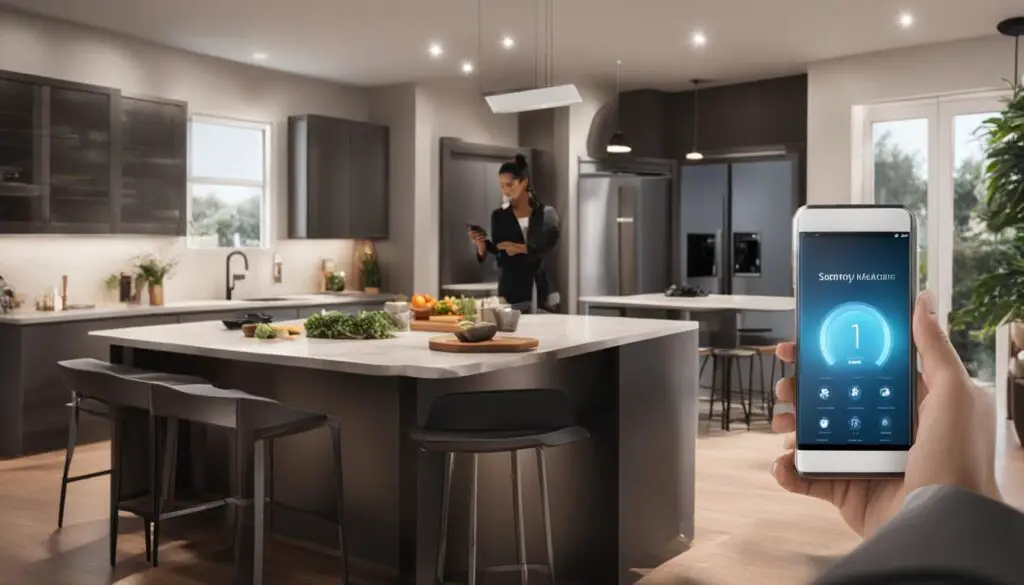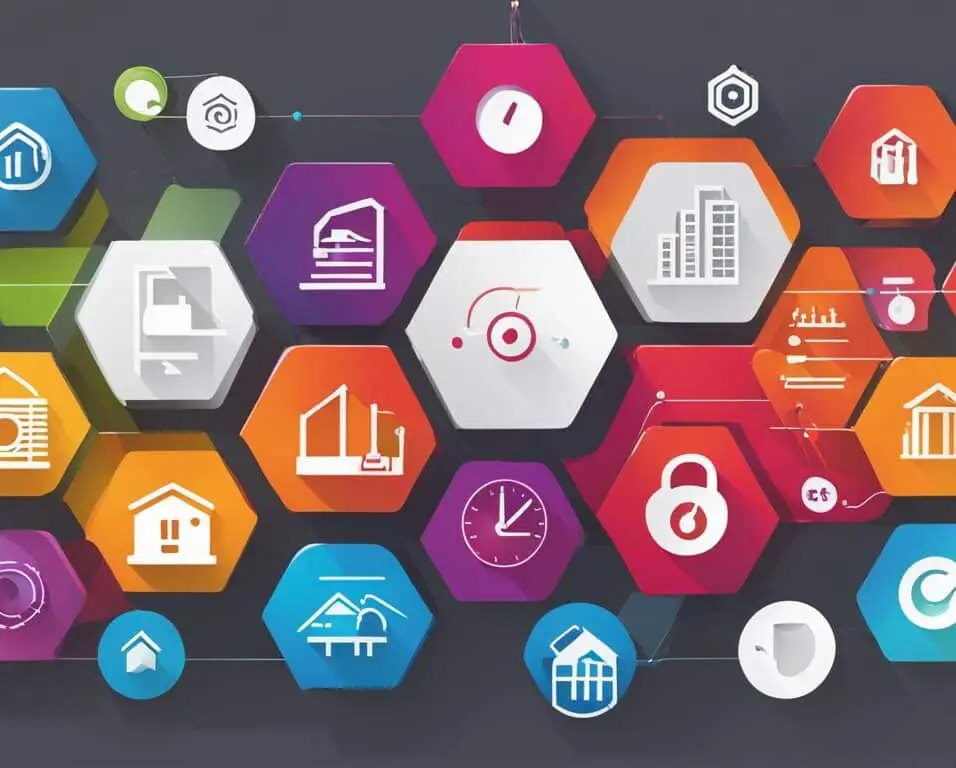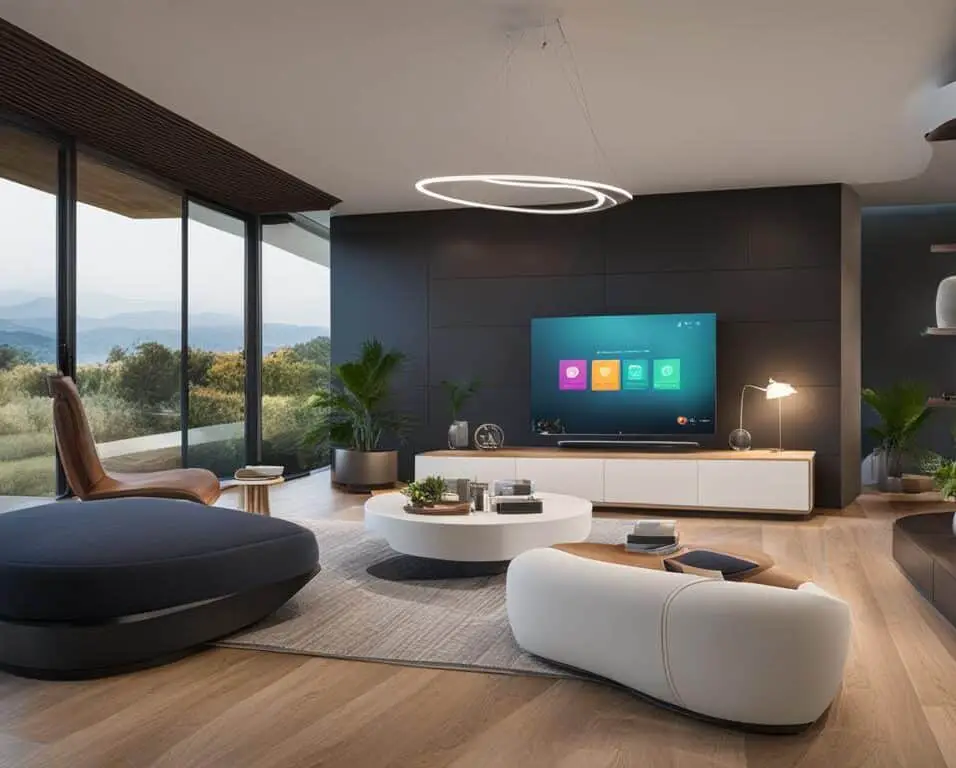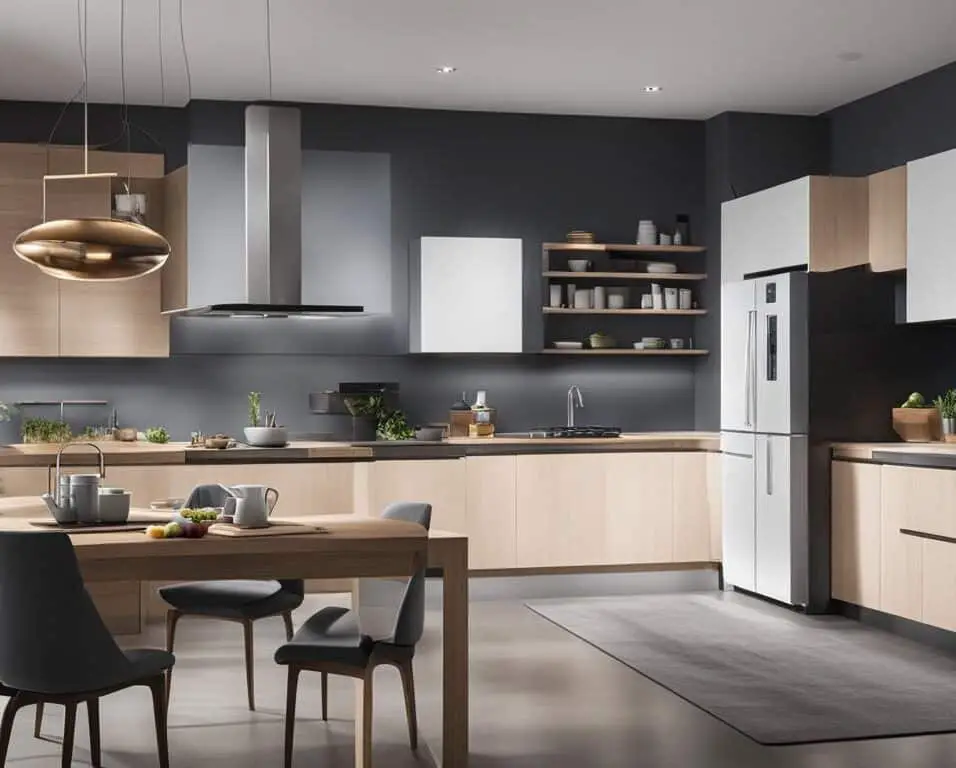AI-Powered Solutions for Smarter Homes
Artificial intelligence (AI) is revolutionizing the way we interact with our homes. With the rise of AI-powered solutions, homes are becoming smarter and more efficient. From chatbots to AI-generated routines and automations, AI is enhancing the overall experience of living in a smart home. This article explores the latest technology trends in smart home automation and how AI is driving innovation in this field.
Key Takeaways:
- Smart home automation is being revolutionized by artificial intelligence (AI).
- AI-powered solutions make homes smarter and more efficient.
- AI-generated routines and automations enhance the smart home experience.
- The latest technology trends in smart home automation are driven by AI.
- AI is shaping the future of smart homes and redefining how we live.
The Role of Generative AI in Smart Home Technology
Generative AI is at the forefront of innovation in smart home technology, offering a range of benefits that enhance the user experience. By harnessing the power of Generative AI, smart homes can achieve new levels of automation, security, and efficiency. This section explores the multiple applications of Generative AI in smart homes and its potential to transform the way we live.
Generative AI enables intelligent enhancements in security footage, generating routines and automations based on learned patterns, and offering predictive maintenance for appliances and systems in the home. With its ability to understand and adapt to user behavior, Generative AI brings a new level of personalization and convenience to smart homes.
One of the key applications of Generative AI in smart home technology is in security systems. By analyzing security footage, Generative AI can identify and track objects, detect anomalies, and enhance the overall security of the home. This enables homeowners to have real-time insights and take immediate action in case of any security threats.
Enhancing Automation with Generative AI
Generative AI also plays a vital role in automating various aspects of smart homes. By learning patterns and routines, Generative AI can generate automated schedules for lighting, thermostats, and other connected devices. This not only simplifies everyday tasks but also creates a more energy-efficient and comfortable living environment.
Additionally, Generative AI contributes to predictive maintenance in smart homes. By analyzing data from connected devices, Generative AI can anticipate potential issues and proactively schedule maintenance. This helps homeowners avoid unexpected breakdowns and ensures that appliances and systems are always running smoothly.
The Potential of Generative AI in Smart Homes
The applications of Generative AI in smart homes are vast and continue to evolve. From personalized recommendations to intuitive automations, Generative AI has the potential to revolutionize the way we interact with our homes. By understanding user preferences, habits, and patterns, Generative AI can create truly personalized experiences, making the home environment more efficient, secure, and enjoyable.
With Generative AI, the possibilities for smart home technology are endless. The fusion of advanced algorithms, machine learning, and artificial intelligence is shaping a future where our homes become intelligent companions, anticipating our needs and seamlessly adapting to our lifestyles.
| Application | Description |
|---|---|
| Security Systems | Generative AI enhances security footage analysis, object tracking, and anomaly detection, improving overall home security. |
| Automation | Generative AI generates automated schedules for connected devices, optimizing energy usage and simplifying daily routines. |
| Predictive Maintenance | Generative AI analyzes data from connected devices to anticipate maintenance needs, preventing unexpected breakdowns. |
| Personalization | Generative AI understands user preferences and patterns to create personalized experiences, enhancing comfort and convenience. |
Voice Assistants and the Evolution of AI in Smart Homes
Voice assistants have become ubiquitous in smart homes, enhancing our daily lives with their ability to perform tasks, answer questions, and control connected devices. But as AI technology continues to advance, voice assistants are evolving beyond their transactional capabilities, becoming collaborative partners in home automation and personalization.
One noteworthy AI model that is driving this evolution is ChatGPT. Powered by OpenAI’s language generation technology, ChatGPT goes beyond simple voice commands, utilizing natural language processing to understand user behavior and preferences. With its ability to learn and adapt, ChatGPT can offer personalized suggestions and recommendations to homeowners, creating customized automations that align with their unique needs.
Through collaborative automation, voice assistants powered by AI models like ChatGPT can suggest new and intricate ways for smart homes to work, based on user behavior and patterns. This empowers homeowners to create a truly personalized and seamless living experience, where their voice assistant becomes a trusted companion and facilitator of daily tasks.
The Impact of Collaborative Automation
Collaborative automation simplifies the process of managing a smart home by harnessing the power of AI. It not only assists with routine tasks but also proactively anticipates and fulfills the needs of homeowners. This level of automation not only enhances convenience but also promotes efficiency, energy savings, and overall well-being.
By leveraging user data and preferences, voice assistants can provide personalized recommendations for optimized energy usage, efficient appliance scheduling, and even suggest potential upgrades or enhancements to the smart home ecosystem. This data-driven approach ensures that homeowners derive maximum benefits from their smart home investments while reducing unnecessary energy consumption.
With collaborative automation, voice assistants become more than just voice-activated responders; they become proactive partners in managing and improving our living spaces.
Furthermore, by collaborating with other connected devices and systems in the smart home network, voice assistants can create synergistic automations that seamlessly integrate various aspects of daily life. For example, a voice assistant can use data from a smart thermostat, occupancy sensors, and weather forecasts to optimize the temperature and lighting conditions in a room, providing a comfortable and energy-efficient environment.
With the evolution of voice assistants and the advent of AI-driven collaborative automation, the possibilities for enhancing smart homes are vast. Homeowners can expect increased personalization, refined routines, and a deeper integration of AI technology into their daily lives.
Comparing Voice Assistants in Smart Home Automation
| Voice Assistant | Key Features | Compatibility | Integration with AI Models |
|---|---|---|---|
| Amazon Alexa | – Voice control for connected devices – Skills for expanded capabilities |
– Wide range of compatible devices – Works with popular smart home platforms |
– Integration with AI models like ChatGPT – Enables personalized recommendations and automations |
| Google Assistant | – Voice control for connected devices – Google services integration |
– Extensive device compatibility – Seamlessly works with Google ecosystem |
– Integration with AI models like ChatGPT – Provides personalized suggestions and automations |
| Apple Siri | – Voice control for connected Apple devices – Deep integration with Apple ecosystem |
– Limited compatibility with non-Apple devices – Provides seamless control within the Apple ecosystem |
– AI advancements in progress – Potential for enhanced collaboration in the future |
Table: A comparison of voice assistants and their features in smart home automation.

As voice assistants continue to evolve and AI models like ChatGPT become more sophisticated, the future of smart homes holds exciting possibilities. Homeowners can look forward to a seamless and personalized living experience, where their voice assistant acts as an intelligent collaborator, optimizing routines, suggesting improvements, and making life more convenient.
AI-Enabled Devices and the Future of Smart Homes
The integration of AI technology in smart homes has the potential to transform the way we live. By harnessing the power of AI, homes can become more intuitive, efficient, and personalized. One significant advancement in this field is the introduction of the open-source standard called Matter, which is supported by industry giants like Google and Apple.
Matter enables seamless interoperability between various smart home devices, allowing them to communicate and work together effortlessly. This standard breaks down compatibility barriers, creating a more connected ecosystem of devices. With Matter, homeowners can expect a smooth integration of AI-enabled devices from different manufacturers, enhancing the overall smart home experience.
The Importance of Interoperability
Interoperability is a critical aspect of smart home technology. With multiple devices and platforms available, ensuring compatibility and easy communication between them is crucial for a seamless user experience. Matter simplifies this process by providing a common language and set of protocols that allow devices to understand each other’s commands and data.
Through interoperability, AI-enabled devices can access immense datasets from various sources, enabling them to provide personalized experiences for homeowners. For example, a smart security system can analyze data from different sensors and cameras to offer tailored security recommendations based on the homeowner’s preferences and historical patterns.
Paving the Way for Personalized Experiences
Personalization is a key aspect of smart homes, and AI plays a vital role in delivering customized experiences. With the interoperability offered by Matter, AI-enabled devices can gather and process data from multiple sources, including smart sensors, voice assistants, and even wearable devices. This wealth of data allows AI algorithms to understand individual preferences and adapt the smart home environment accordingly.
For instance, AI can learn the homeowner’s daily routines, preferences for lighting and temperature, and even preferred music genres. With this knowledge, AI-enabled devices can automatically adjust settings, create personalized lighting scenes, and curate tailored music playlists to enhance the homeowner’s comfort and convenience.

Smart Home Electronics and Appliances for a Connected Living
When it comes to creating a truly connected living environment, smart home electronics and appliances are essential. These devices not only enhance our daily activities but also make our homes more comfortable and efficient. Whether you’re in the living room, kitchen, or even outdoors, there’s a wide range of smart devices that can bring convenience and automation to every corner of your home.
Outdoor Devices
Let’s start with outdoor devices, which are designed to make your time spent outside more enjoyable and hassle-free. Picture this: you’re relaxing by your pool, and suddenly you realize that the water needs testing. With a smart pool water monitor, you can easily monitor and control the water quality right from your smartphone. And don’t forget about smart lawn mowers that can keep your lawn perfectly trimmed without any effort on your part. These outdoor devices seamlessly integrate with your smart home system, allowing you to maintain and beautify your outdoor spaces with ease.
Living Room Area
The living room is the heart of the home, and it deserves the best smart devices to enhance your entertainment experience. A smart TV is a must-have, allowing you to stream your favorite shows and movies with the touch of a button or even through voice commands. Pair it with voice-controlled lighting, and you can create the perfect ambience for movie nights or parties without lifting a finger. These smart devices not only offer convenience but also create a more immersive and enjoyable living room experience.
Smart Kitchen Appliances
In the kitchen, smart appliances can transform your cooking routine and automate household chores. Imagine having a smart refrigerator that keeps track of your groceries and sends you reminders when it’s time to restock. With a smart oven, you can preheat it on your way home, ensuring that dinner is ready as soon as you walk through the door. And who wants to wash dishes after a satisfying meal? Let a smart dishwasher take care of that for you. These smart kitchen appliances not only save you time but also bring a new level of convenience to your culinary adventures.
Miscellaneous Devices
Lastly, there are various miscellaneous smart devices that can be integrated into your smart home setup. From smart thermostats that adjust the temperature based on your preferences and habits to smart locks that provide enhanced security and keyless entry, these devices add convenience, comfort, and peace of mind to your daily life. The possibilities are endless, and the choice of smart home electronics and appliances is vast, catering to every aspect of your connected living experience.
| Smart Home Electronics and Appliances | Main Features |
|---|---|
| Smart Pool Water Monitor | Monitors and controls water quality in the pool |
| Smart Lawn Mower | Keeps your lawn perfectly trimmed |
| Smart TV | Streams your favorite shows and movies |
| Voice-Controlled Lighting | Creates the perfect ambience with voice commands |
| Smart Refrigerator | Keeps track of groceries and sends restock reminders |
| Smart Oven | Preheats and cooks meals efficiently |
| Smart Dishwasher | Automates dishwashing for a hassle-free cleanup |
| Smart Thermostat | Adjusts temperature based on preferences and habits |
| Smart Lock | Enhances security and offers keyless entry |
By incorporating these smart home electronics and appliances into your living space, you can create a truly connected and intelligent home that simplifies your everyday tasks and elevates your lifestyle. Embrace the convenience, efficiency, and comfort of a smart home setup, and experience the seamless integration of technology in every aspect of your life.
Conclusion
AI has revolutionized the way we live in our homes, offering an unprecedented level of convenience, efficiency, and peace of mind. Smart homes powered by AI technology have become the new norm, providing homeowners with intuitive and connected living spaces.
With the help of AI-enabled voice assistants, such as Amazon Alexa and Google Assistant, homeowners can effortlessly control various aspects of their homes, from adjusting the temperature and lighting to managing their entertainment systems. These voice assistants have evolved to become collaborative partners rather than just transactional tools, offering personalized recommendations and tailored automations based on user behavior.
Furthermore, AI-driven predictive maintenance ensures that our appliances and systems operate at their optimal levels, reducing the risk of breakdowns and improving their lifespan. The integration of AI technology also allows for seamless interoperability between different smart home devices, making it easier than ever to create a personalized and interconnected ecosystem within our homes.
The future of AI-enabled smart homes promises even more exciting possibilities. We can look forward to intuitive home automation systems that learn and adapt to our preferences, personalized AI companions that anticipate our needs, and predictive algorithms that optimize energy usage and enhance overall efficiency. Embracing the smart home revolution means embracing a more connected and intelligent way of living, where convenience, efficiency, and peace of mind are seamlessly integrated into our daily lives.
FAQ
How is AI powering smarter homes?
AI is revolutionizing smart homes by enhancing automation, security, and efficiency. Through AI-powered solutions, homes are becoming smarter and more convenient to live in.
What is the role of generative AI in smart home technology?
Generative AI plays a crucial role in smart home technology by enabling intelligent enhancements in security footage, generating personalized routines and automations, and offering predictive maintenance for appliances and systems in the home.
How are voice assistants evolving in smart homes?
Voice assistants, like Amazon Alexa and Google Assistant, are evolving to become more than just transactional tools. AI models like ChatGPT enable voice assistants to suggest customized automations and provide personalized recommendations based on user behavior.
How does AI enable interoperability in smart homes?
AI technology, such as the open-source standard Matter, allows for seamless interoperability between smart home devices. This allows AI-enabled devices to access vast datasets and provide personalized experiences for homeowners.
What are some examples of smart home electronics and appliances?
Smart home electronics and appliances include devices like smart TVs, voice-controlled lighting, pool water monitors, lawn mowers, smart refrigerators, ovens, and dishwashers. These devices enhance daily activities and automate household chores.
What benefits do AI-enabled smart homes offer?
AI-enabled smart homes offer unprecedented convenience, efficiency, and peace of mind for homeowners. With enhanced security systems, predictive maintenance, and personalized AI companions, AI is redefining the way we live and interact with our living spaces.








